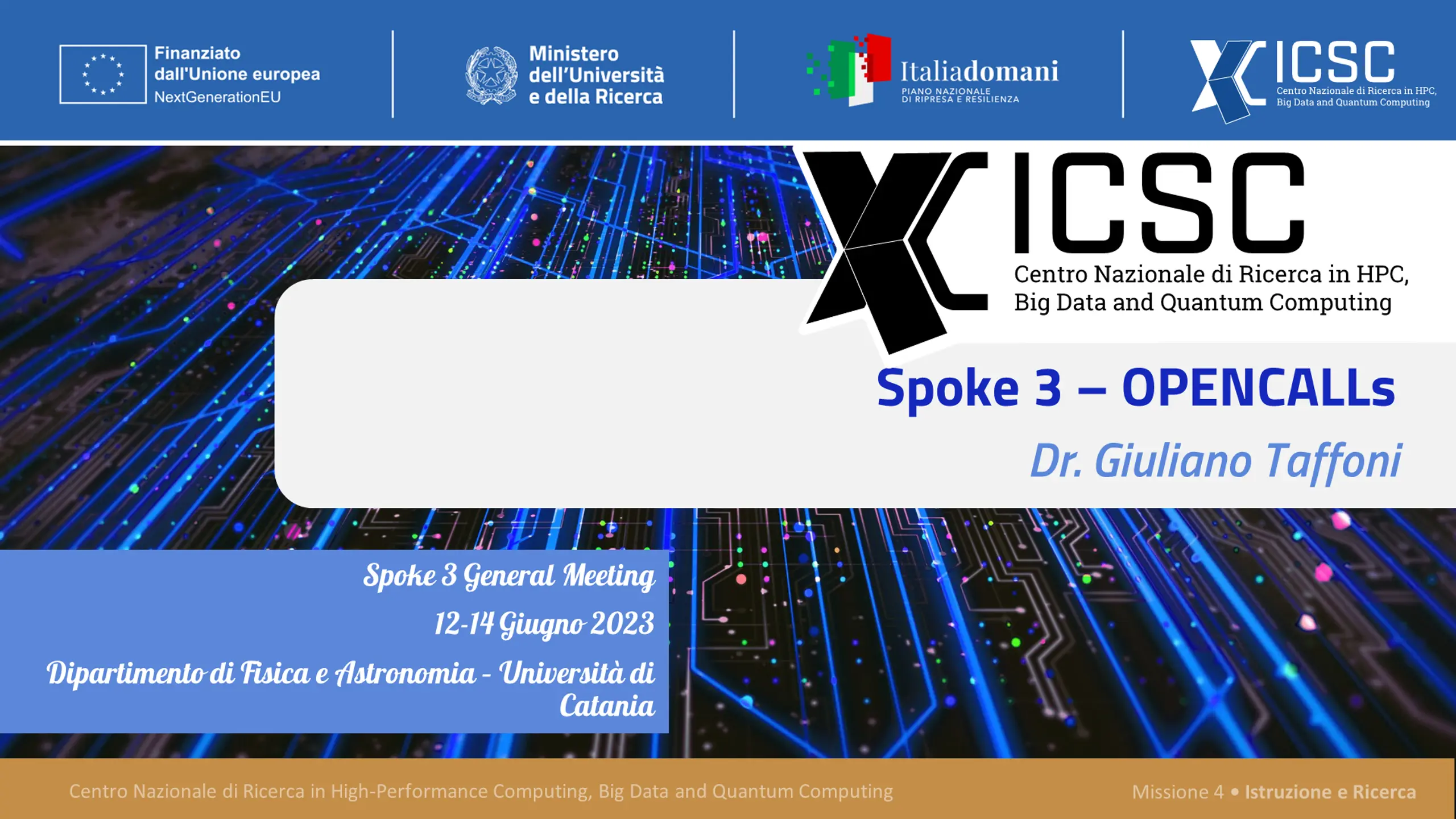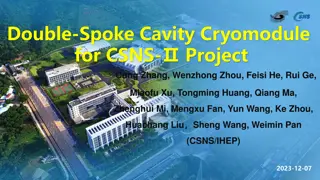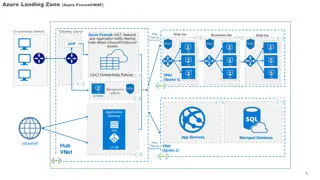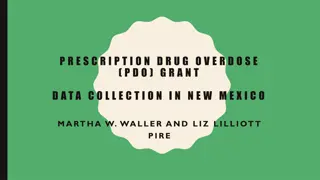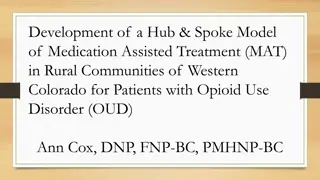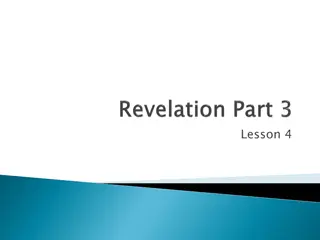Spoke 3 OPENCALLs
Introduction to the cascade calls for SPOKE3 ideas collected by WPs and partners, including budget and constraints discussions.
Download Presentation

Please find below an Image/Link to download the presentation.
The content on the website is provided AS IS for your information and personal use only. It may not be sold, licensed, or shared on other websites without obtaining consent from the author.If you encounter any issues during the download, it is possible that the publisher has removed the file from their server.
You are allowed to download the files provided on this website for personal or commercial use, subject to the condition that they are used lawfully. All files are the property of their respective owners.
The content on the website is provided AS IS for your information and personal use only. It may not be sold, licensed, or shared on other websites without obtaining consent from the author.
E N D
Presentation Transcript
Spoke 3 OPENCALLs Dr. Giuliano Taffoni
Agenda e scopo della Sessione Introduzione ai Bandi a Cascata per SPOKE3 Idee Raccolte dai WPs e Partners Budget and Constraints Discussione discussione discussione
Bandi a Cascata (BC) per Spoke 3 Lo Spoke 3 ha un finanziamento complessivo di 3.2 Mln di Euro Il soggetto titolato a emettere i bandi lo Spoke Leader (INAF) Riguardano argomenti proposti da tutti i partners dello SPOKE3 Sono inserite nelle attivit dei WPs Proposte di BC sono state raccolte, da Partners e WP leaders. Siamo aspettando che venga definito un regolamento dal HUB.
Bandi a Cascata: cosa sono? Siamo in attesa di un regolamento finale ma sono riservate a soggetti pubblici o privati non coinvolti nel CN; 50% del budget destinato al Sud ( che in pratica si traduce in?...)
Bandi a Cascata: Regole La struttura regolamentare e amministrativa del bando responsabilit dello SPOKE; Ove i destinatari del bando siano soggetti privati e/o imprese, lo SPOKE dovr curare con attenzione il rispetto delle regole vigenti in tema di aiuti di stato; Le offerte debbono essere valutate da soggetti terzi e indipendenti; I soggetti vincitori dei bandi debbono osservare tutte le regole di rendicontazione scientifica e amministrativa in uso per i progetti PNRR; BC verranno valutate dall HUB (Industrial Board e CdA)
Bandi dello Bandi dello Spoke Spoke3 3 16 for Private Sectors Areas of Interest Advanced optimization (Acc, Hybrid platforms, extreme IO ) Scientific Visualization and Archives WPs and Partners collected 28 Ideas On line document to discuss with the SPOKE Assembly Machine Learning and Deep learning Access to Innovative HW 6 mixed 6 for Public Sectors Centro Nazionale di Ricerca in High-Performance Computing, Big Data and Quantum Computing Missione 4 Istruzione e Ricerca
Argomenti e fondi Arguments Work Package WP1/WP2 WP3 WP$ Accelerators Optimization& Porting Visualization IO ML&DL
Who and Where Localization Target Budget Europe Italy SUD Private Public Mix < 100 KE ~100 KE > 100 < 200 KE
Advanced development of big scientific data visualization tools, with support for remote and immersive rendering. Data comes from (observational and theoretical) astrophysics and geophysics. Development/upgrade of scientific visualization tools for latent space data exploration, labelling and analysis Interactive visualization infrastructure for the HPC Center Proponente: INAF Proponente: SNS Proponente: INAF Soggetto: Privato Soggetto: Privato Soggetto: Privato Area: Europa Area: Europa Area: Italia Budget: ~200kE Budget: ~180kE Budget: ~50kE WP3 WP3 WP3
Advanced school and/or courses for outreach and dissemination in the fields of Astrophysics, High Performance Computing and Big Data. Innovative start-up support for school, courses or Master in Science Communication (MCS) on several themes: communicating with the media and the public, peer to peer science communication, Public Engagement How to facilitate the dialogue with various audience, science on air: how to develop a podcast, etc Parallelization and testing of existing simulation codes for cosmological instrumentation in view of the optimization of the analysis pipeline for CMB experiments to GPUs and other HPC hardware (relevant projects: LiteBIRD, LSPE, Simons Observatory, CMB-S4) Optimization and performances testing of CUDA-(multi)GPU- accelerated codes for the automatic parameterization of physical models based on SDE Monte Carlo algorithms Proponente: SISSA+INAF Proponente: INFN Proponente: INFN Soggetto: Privato Soggetto: Pubblico Soggetto: Pubblico Area: SUD Area: Nord Area: Sud Budget: ~200kE Budget: ~100kE Budget: ~200kE WP0 WP1/WP2 WP1/WP2
Porting and optimization of codes for cosmological simulations on architectures with accelerators, primarily GPUs, but also FPGA. The two codes of specific interest are OpenGADGET and PINOCCHIO. Different approaches to accelerations can be investigated using programming frameworks such as OpenMP or OpenACC or GPU specific libraries such as CUDA. Code portability and performance (also in terms of energy consumption) will be addressed as well Enabling innovative hardware and software (e.g., RISC-V processors and/or RISC-V-based computing accelerators) for the astrophysical characterization of gravitational-wave transients, and optimization/comparison with last-generation GPU-based platforms (e.g., HGX H100) High Performance I/O: experimentation and optimization of I/O strategies adopting innovative High Performance storage devices, parallel filesystems or object storage solutions, I/O libraries (in particular HDF5 and ADIOS) Proponente: SISSA Proponente: UniTS Proponente: INAF Soggetto: Privato Soggetto: Privato Soggetto: Privato Area: Europa Area: Sud Area: Nord Budget: ~200kE Budget: ~100kE Budget: ~200kEx2 WP2 WP1/WP2 WP1/WP2/WP4
Innovative Hybrid Accelerated Architectures: experimentation of advanced heterogeneous accelerated architectures in order to verify their usage on (parts) of simulation/data analysis codes. Each different accelerated solution could be optimal for a different algorithmic solution (so for a different part of the code) Machine Learning: development of specialized HPC enabled algorithms for the application of Machine Learning solutions to problems specific to astrophysical data processing, analysis and visualization Questo molto vago. Cosa vuol dire? Development of a Machine Learning based tool for charged particle track reconstruction in a spaceborne tracker Proponente: INAF Proponente: INFN Proponente: INFN Soggetto: Privato Soggetto: Pubblico Soggetto: Pubblico Area: SUD Area: Europa Area: Sud Budget: ~200kEx2 Budget: ~200kE Budget: ~150kE WP0 WP1/WP2 WP3
Sviluppo di strategie di elaborazione automatica di immagini basate su machine- learning per il rilevamento automatico dell'attivit vulcanica e, in particolare, di fontane di lava da termocamere di monitoraggio a terra Sviluppo di tecniche di deep learning con integrazione di physics-based priors per elaborare immagini complesse al fine di rilevare precursori di disastri naturali e antropici Development of a Machine Learning Algorithm for very low energy Gamma-ray imaging Proponente: INFN Proponente: UniCT Proponente: UniCT Soggetto: Priv Soggetto: Pub Soggetto: Pub+Priv Area: SUD Area: Sud Area: Sud Budget: ~150kE Budget: ~60kE Budget: ~60kE WP3 WP32 WP2
Development of innovative techniques for detection, recognition, and classification of coherent structures and discrimination of signal from noise in images, time-series and spectra of astrophysical nature. Development of innovative techniques (Machine Learning, pattern recognition etc) for mitigation of the radio frequency interferences (RFIs) in noise-dominated time- series of astrophysical nature Sviluppo di tecniche numeriche e codici basati sull'apprendimento automatico al fine di modellare fenomeni esplosivi quali Supernovae e transienti simili Proponente: UNICT Proponente: TOV Proponente: INAF Soggetto: Pub Soggetto: Pubblico Soggetto: Priv Area: SUD Area: Sud Area: Sud Budget: ~45kE Budget: ~100kE Budget: ~100kE WP3 WP3 WP3
The objective of this project is to develop a machine learning algorithm capable of detecting physical features in astrophysical data cubes. This algorithm will be able to detect and quantify features such as extended emission regions, filaments, and diffuse gas clouds in astrophysical images, and faint resonant lines in spectral datasets. The project will involve designing and training a machine learning model using existing astrophysical images with known extended features and spectral datasets with resonant lines, followed by testing the algorithm's accuracy and precision on a set of independent data cubes. The objective of this Open Call is to accelerate the performance of the XMAP, WINE and TEPID software packages by leveraging the computational power of a GPU. In particular, the XMAP package is a scientific software devoted to analyze X-ray and microwave data obtained by XMM-Newton, Chandra, Planck and SPT observatories. It has been identified that it can dramatically benefit from parallelization on GPUs. The project will involve identifying the computationally intensive sections of the codes and optimizing them for execution on GPUs Porting in a HPC context of bayesian analysis codes with several tens/hundreds of free parameters . Proponente: INAF Proponente: TOV Proponente: TOV Soggetto: Priv Soggetto: Priv Soggetto: Priv Area: SUD Area: Sud Area: Sud Budget: ~100kE Budget: ~150kE Budget: ~100kE WP3 WP1/WP2 WP3
Archive implementation. The goal is to build a smart architecture to allow data organization and management with the possibility to easily interact with the computational cluster. Creazione di interfacce low-code per l'utilizzo di algoritmi di matematica applicata avanzata e deep learning in contesti di ricerca, data analytics e produzione Ricerca di sorgenti transienti nei dati raccolti da esperimenti gamma di alta energia tramite metodi di Machine learning Proponente: INAF Proponente: UniTO Proponente: UniTS Soggetto: Priv Soggetto: Pub+Priv Soggetto: Pub+Priv Area: SUD Area: Sud Area: Italia Budget: ~80kE Budget: ~80kE Budget: ~100kE WP4 WP3 WP3
Sviluppo e applicazione degli algoritmi di deep learning, in particolare reti neurali, per l'analisi dei dati (incluse time series) provenienti da missioni spaziali. Efficient Particle interaction Software on High Performance Computing Proponente: UniTS Proponente: INAF Soggetto: Pub+Priv Soggetto: Pub+Priv Area: Italia Area: Italia Budget: ~100kE Budget: ~100kE WP3 WP3
Sviluppo e applicazione degli algoritmi di deep learning per l'analisi di dati astrofisici da missioni spaziali (es. Euclid). Implementazione di algoritmi per la riduzione di dimensionalit e identificazione di feature fisiche/strumentali predominanti. Analisi ed interpretazione dello spazio latente per individuazione delle componenti principali, per inferenza di parametri cosmologici e/o astrofisici. Generazione di dataset sintetici in diversi scenari astrofisici/cosmologici Proponente: INAF Sviluppo e applicazione degli algoritmi di deep learning per lo sfruttamento di dati da distribuzioni 3D point-clouds non strutturate in voxel (e.g. simulazioni/dati cosmologici). Ottimizzazione di reti deep con tecniche NAS per rappresentare e analizzare distribuzioni 3D point-cloud. Visualizzazione, analisi e interpretazione dello spazio latente per la generazione di distribuzioni point-clouds in diversi scenari cosmologici e/o astrofisici. Proponente: INAF Soggetto: Priv Soggetto: Pub Area: Italia Area: Italia Budget: ~170kE Budget: ~130kE WP3 WP3
Questions and Discussion Questions and Discussion
